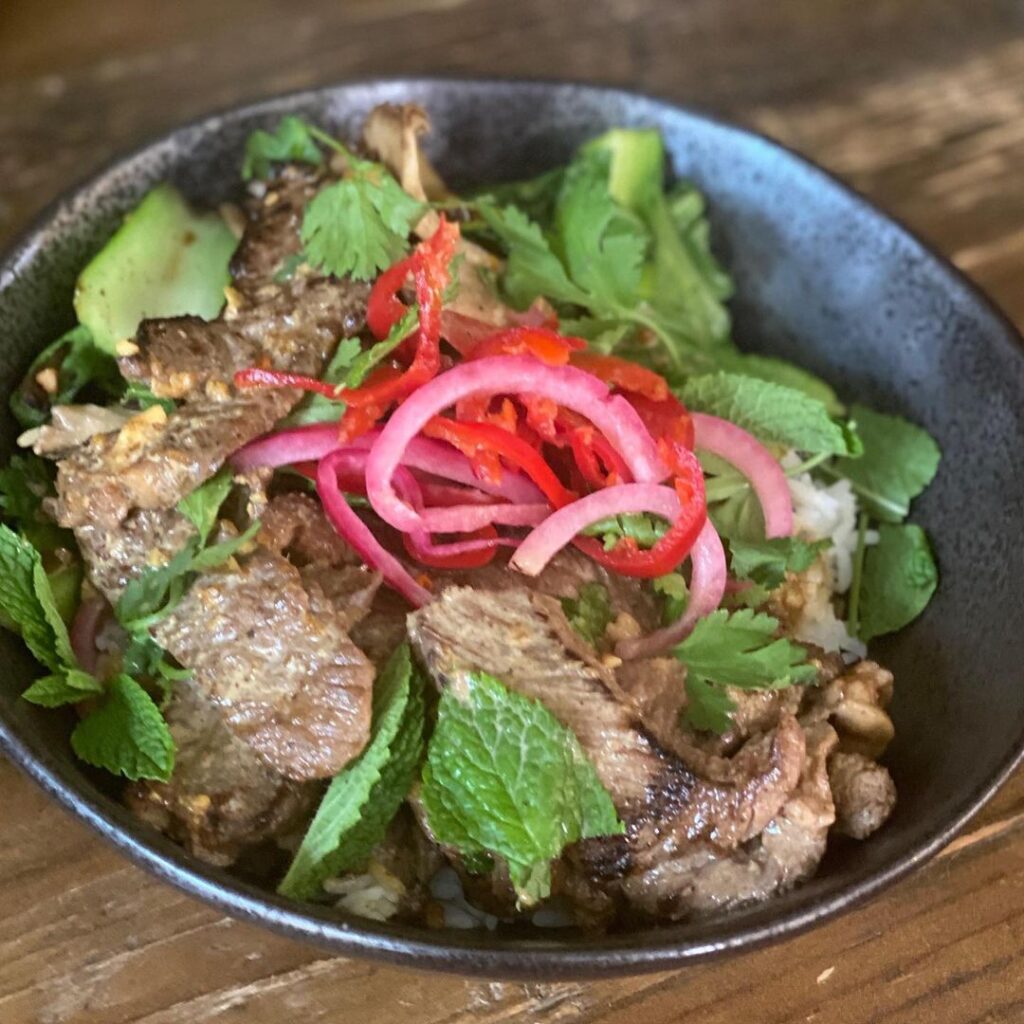During the course of your time in academia—first, enrolled in anascent “food studies” program and, later, one devoted to interdisciplinarysocial science research—a specter haunted you. Within otherwise pleasant classeson the “anthropology of food,” “food culture,” or “multiculturalism in liberaldemocracies,” for example, the apparition would suddenly emerge. The meremention of its name, five syllables in length, would bear down on anydiscussion like a freight train, clouding the critical thinking which hadreigned up until its entrance.
The power this phantasm claimed over your peers made your blood boil. Throughoutmany of these manifestations, you could only stew in your seat, stunned by thewraith’s insidious sway. It held an uncanny ability to transform crusaders forequality and cross-cultural acceptance into the most craven defenders of asegregated, stagnate manner of artistic creation. Its acceptance andproliferation as a valuable construct would demean, in your mind, the intellectualhonesty of otherwise distinguished professors. It would sully, by means of stagingan asymmetrical discourse, campuses that had thereto been committed to the freeexchange of ideas.
Towards the tail end of your time in academia, you would simplysidestep ever engaging with this ghost. You could not trust yourself to holdyour temper, to avoid engaging in the exorcism this poisonous spirit so desperatelydeserved. For, this specter’s invocation invariably proceeded via a certainsort of person. Like black magic, its allure laid in appealing to those whoviewed themselves as powerless. It would turn the tables, the phantom wouldpromise, for the meager price of a soul. Alas, it is not the individual’s soulwhich pays for this dance with the devil. Rather, through the public’s sycophancyin the face of this charade, it is the very soul of art in gastronomy thatsuffers.
“Authenticity,” of course, is the dreaded word—that bugaboo whose “real”meaning nobody can quite unravel. (Are tomatoes “authentic” to Italian cuisinesince they came from the New World? Are hamburgers “authentic” to Americancuisine since they came from Hamburg?) But that sure as hell doesn’t stop theconcept from being wielded against all and sundry who are perceived to bestepping on the toes of this or that whiny minority.
The most recent flashpoint in this battle of cultural asphyxiationbetween “have-talents” and the “have-nots” concerns Chicago’s own Iron Chef.Stephanie Izard has run the city’s ever-popular Girl & the Goat for morethan a decade. Having opened in 2010, it still stands, in your mind, as theprototypical American restaurant of the future. Intimately engaged in localsourcing of ingredients and nose-to-tail cooking from the start, Izard’sever-changing menus embrace the totality of our nation’s culinary influences.Hamachi crudo is paired with crisp pork belly, tempura soft shell crab withsweet corn elote, escargot ravioli with tamarind-miso sauce, and duck tonguewith tuna poke and crispy wontons (to name but a few dishes).
What Izard cooks can in no way be called “fusion.” The recipes are notcontrived in such a way, nor does the restaurant ever embrace such an identity.Instead, she simply takes inspiration from the full wealth of the world’singredients and techniques and applies them to the Midwest’s natural bounty.Hers is an intuitive, untethered form of cooking that prevails through combiningunorthodox textures and flavors in a way that is invariably balanced and highlycomforting. Reading “beef heart,” “beef tongue,” or “pig face” on a menu mightmake some of Izard’s fans squeamish at first. Yet you would wager nobody whohas placed trust in those dishes’ execution has walked away unsatisfied. Likewise,unfamiliar or “foreign” ingredients may be removed from their cloisters and treatedas a peer in the great American pantry, going on to form surprisingpartnerships with other fare.
As scary as a dish may “read” on a menu, the proof is always in thepudding. One need only get customers to sample that first bite, and a wholeworld of preconceived disgust may be wiped away. Girl & the Goat’s staff isadept at assuaging those fears (even offering free samples of dishes someonemay never muster up the courage to order), and the kitchen is sure not to letthe opportunity go to waste. Izard has earned an implicit sense of trust bytransforming so many skeptical diners into believers, and you think few figuresin American dining have done so much to expand guests’ palates in thisgeneration. All, again, without any conscious goal but to cook the mostexciting and enjoyable “American” food possible—talk about a triumph of goodtaste!
In 2012, Izard opened Little Goat, an ode to the classic Americandiner that, nonetheless, throws many of the same culinary curveballs as theGoat “mothership.” Sure, one can order shrimp and grits, biscuits and gravy,pancakes, patty melts, milkshakes, and sundaes there—each accented with thechef’s eye for amping up decadent flavors. But how about a Spanish omelette, apork belly okonomiyaki, a scallion pancake, a bánh mì, some Szechuan sausage,or a “bi bim bop” breakfast bowl made of cauliflower “rice,” guanciale, pickledvegetables, and sunny side up eggs? While such dishes are nominally “foreign,”they, like the aforementioned classic offerings, are interpreted through Izard’ssingular perspective. In this manner, an array of diverse comfort food “forms”are translated through the Goat ethos with an even hand. What dishes patronsmay recognize as belonging to a “traditional” American diner merely serve as aleveling influence and jumping off point for an altogether new canon.
In this sense, Little Goat’s menu seems to redefine the American diner(often, ironically, Greek-run and betrothed to the same standard farethroughout the country) as a “big tent” encompassing a range of global comfortfoods. Izard does not serve traditional American recipes alongside a shoehornedselection of superficial “ethnic” recipes. She does not engage in any consciousmanner of fusion or “Americanization” of her Japanese, Chinese, Vietnamese, orKorean victuals. Rather, one gets the sense that she designed the diner’s menuto encompass as many pleasing comfort foods as she could think of and decided uponhow to give each of them a personal twist. That meant treating all theingredients, all the archetypal forms, as equals and engineering them in such away as to maximize flavor and texture. Little Goat’s menu—like Girl & theGoat’s—embodies the free exchange of cultural influences that art has taken forgranted since time immemorial.
With Duck Duck Goat and Cabra—opened in 2016 and 2019 respectively—Chicago saw Izard apply herself more particularly towards other cultures’ fare. The former, building on the glimpses of Chinese flavors seen at the other Goat properties, promises “reasonably authentic Chinese food” while the latter terms itself a “Peruvian-inspired” restaurant. Far from being arbitrary, appropriated concepts, you think both establishments extend the same Goat ethos that Izard applied to Little Goat’s diner format.
Duck Duck Goat—if the “reasonably authentic” moniker didn’t tip you off—indulges freely in the kitsch many Americans associate with “Chinese” (in truth, Chinese-American) cuisine. To start, the décor is an amalgamation of every “Chinese restaurant” trope possible: lanterns, faded family photos, lazy susans, lacquered wood, and plush cushions and curtains in shades of crimson. Such an environment does not aim for “reality” but stands, instead, more like a movie set, an integrated hyperreality. It winks and nods at the average American’s imagined “Chinese restaurant,” thus tapping into a subconscious form of familiarity that comes across as charming. (Little Goat, it must be said, pulls the same trick in its staging of the archetypal “retro diner”).
The menu plays its part too, featuring oversized pictures and a codedsystem of identifying dishes written in Chinese then English. The fare itselfruns the gamut of cold dishes, dim sum, noodles, fried rice, and “chef’sdelights” one expects from their corner take-out joint. There’s “boozy bubbletea” and Peking duck too. Seemingly, the offerings are ordinary (relative tothe setting), but some of Izard’s identity as a chef shines through. Ricedumplings are filled with goat, Sichuan eggplant is married with goat sausage,egg foo young are made with goat bacon, lo mein is paired with goat belly, andpig face features in its own set of buns. Beef—whether used in potstickers orwonton soup—is invariably from the short rib. Meanwhile, dishes of grilled duckhearts, grilled whole fish, and grilled lamb (with garlic aioli and lime garliccrunch) would be right at home on Girl & the Goat’s own menu. All thingsconsidered, Izard actually shows quite a bit of restraint in her interpretationof the “Chinese-American” canon. She introduces some of her favoriteingredients into the mix while, largely, focusing on making a wider range ofdishes accessible to the sort of customer who reliably orders the same disheswithin the genre. She takes nothing away from regional Chinese cuisines whilegently steering her audience towards a deeper engagement with the culture.
Cabra, in much the same far-flung fashion, “draws inspiration fromStephanie’s travels throughout Peru in Lima, Arequipa and Cusco.” This includedtime spent alongside Mitsuharu Tsumura, whose restaurant Maido was voted “The BestRestaurant in Latin America” in 2017 and 2018, as well as the world’s tenthbest restaurant in 2019 (according to William Reed’s admittedly opaque “World’s50 Best” list). According to Izard, she was struck by “the combination ofbright, light flavors like citrus paired with rich ingredients like cheese ormayo in unexpected ways,” not to mention “the antichuchos, marinated meatsfreshly grilled over flames” and “the ceviches.” The rooftop space—one of twoBoka Restaurant Group anchors for Fulton Market’s Hoxton hotel—features décor “purchasedin the markets of Peru.” Just what elements of the ambiance that comprises areunclear to you, but it’s a sleek space filled with light-colored wood andaccents of orange and turquoise. You may even term it “understated” in itsrepresentation of Peruvian culture (a gesture of respect relative to the caricaturizeddiner and “Chinese” restaurant concepts). As far as Chicago rooftop dininggoes—where style often trumps substance—you think it’s an admirable effortexecuted with the same detail as the “other” Goats.
Relative to Duck Duck Goat, Cabra’s menu aims to make a broad range ofPeruvian fare friendly and accessible to unsuspecting hotel guests. Remember, Izarddoes not wield the world “authentic” in her description of the concept. Peru isinspiration, which implies a filtering of lived experience through a personallens. Thus, while her Chinese-American menu at Duck Duck Goat leads fans closerto an appreciation of more “traditional” fare, Cabra’s menu intends to makePeruvian cuisine more legible to the masses via her beloved “Goat” style. Sucha style, harkening back to Girl & the Goat’s menu, exhibits a mastery ofapplying local ingredients to diverse forms, combining flavors and texturesthan span different cultures.
For example, a “classic” ceviche features bass with baby sweet potatoslices. It leads a section that includes shrimp, salmon, snapper, and duckvariants with various leches del tigre and a panoply of other ingredientslike pistachio, dragon fruit, trout roe, pickled mango, and gooseberries. Izardalso serves a selection of dips—something of a common thread seen at LittleGoat and on occasion of the chef’s past Super Bowl offerings (which included abonafide seven-layer dip). The choices at Cabra include “hot chorizo &queso,” “avocado,” “ají verde & queso fresco,” and “salmon huancaina” eachserved with unique chips. Anticuchos—those “freshly grilled,” “marinated meats”—featurebeef heart, chorizo, chicken thigh, and kampachi. Empandas are made from goat, ajíde gallina (a Peruvian chicken stew), and “swiss chard & kale.” Thelargest plates on the menu are the whole fish (usually snapper) served with “baconsweet & sour” and the chicharrón del puerco, a “skin-on fatty porkshank” that offers a Peruvian spin on the “crispy braised pork shank” that hasbecome a signature at Girl & the Goat.
As with Duck Duck Goat, Cabra’s menu rests on a foundation of traditional forms of cookery which enable Izard’s particular culinary viewpoint to shine through. Some dishes embrace a more “classic” style of flavor construction or seek to package a favorite dish from Peruvian culture (ají de gallina) in an engaging form like the empanada. Others, like the duck ceviche, chorizo and queso dip, beef heart anticucho, and pork shank speak to something of the “Goat” identity. In any case, Izard’s mastery of combining flavors and textures is fit into recognizably Peruvian forms, serving to lead customers towards (even if by “baby steps”) a deeper appreciation of the cuisine.
Having conducted this primer on the range of Izard’s cooking, you can now turn to the controversy at hand. As part of her sponsored content for New Zealand Beef & Lamb, the chef shared a recipe for “bibimbap” featuring sliced strip steak, maitake mushrooms, and bok choy with pickled red onion and Fresno chilis served atop white rice. The dish is dressed with a ginger vinaigrette (made from mayonnaise, soy sauce, mirin, ginger, garlic, sesame oil, Thai green chilis, and yuzukosho) then garnished with fresh mint and cilantro.
“Bibimbap,” by one definition, is described as “a hot Korean dish made with rice, cooked vegetables, and chili, sometimes also with sliced meat and an egg on top.” Another source clarifies that the word’s literal meaning in Korean is “mixed rice,” and that typical vegetables used in the dish “include carrots, cucumber, spinach, bean sprouts, shiitake mushrooms and braken fern.” Some variants of the recipe, like that ascribed to Jeonju, feature “up to 30 ingredients” like “sesame oil, ginkgo nuts, mung bean jelly, steak tartar [sic], egg, and…gochujang chile sauce.” The post, which is itself sponsored by the Korean Food Foundation, notes that “in some Korean cookbooks intended for an English speaking audience, bibimbap recipes might be disguised as ‘Vegetable Rice Bowl’ or some other variation.”
With this in mind, let us look at Izard’s version of bibimbap. Thesliced steak is typical of the recipe, as are the mushrooms. The bok choy isatypical, but not altogether removed from the texture carrots, cucumber, orbean sprouts might provide. Likewise, the pickled red onion and Fresno chilisdo not make for a traditional kimchi, yet red onions are used tomake kimchi, pickled vegetables are used to top bibimbap, and theFresno chilis do represent a more measured introduction of the same “chilesauce” element that might otherwise prove too aggressive for American palates.The same could be said about the Thai green chilis and yuzukosho (apaste made from fermented chili peppers and citrus peel) utilized in the gingervinaigrette, which further serve to make up for the lack of gochujang in therecipe. Izard’s use of sesame oil, of course, is not out of place. But thefresh mint and cilantro certainly are—though perhaps not wildly different fromthe role greens like spinach and bracken fern might play texturally. Of course,Izard’s chosen herbs also continue to serve the purpose of moderating the heatof the various chili elements.
Structurally, the Iron Chef’s bibimbap sounds true to type. Shepresented the dish without any claim to “authenticity” or “tradition,” just as thedishes at her restaurants might draw on a particular culture’s recipe butalways imply its channeling through her creative ethos. (A good example, you think,are the “grilled kalbi beef ribs” which appeared on Girl & the Goat’s menu,featuring “sweet corn coblettes” and “charred okra relish” that take the dish ona journey from Korea to the American South). Izard’s bibimbap is not aningredient-by-ingredient reconstruction, but rather a riff which retains thespirit of the original: sliced meat, cooked vegetables, pickled vegetables,chili heat, and rice.

Yet, being posted on Instagram, the bibimbap’s presentation raised afew eyebrows and quickly caused a furor. You see, if there’s one sin that Izardcommitted, it would be sharing such a sad picture of the completed recipe. Theresolution, angle, and cropping are all poor. Further, the construction of thedish itself resists any identification as a “bibimbap.” The rice and bok choybeing almost totally obscured, the viewer is left to focus on a bowl filledwith slices of beef, strewn with mint and cilantro, with a small pile of thepickled vegetables in the center. By comparison, nearly any variant of a “typical”bibimbap is served with its various toppings neatly compartmentalized at thetop of the bowl, a presentation that is both aesthetically pleasing and thatallows for the diner to combine the components as they please. This, of course,is where the “egg on top” comes in (an addition to the recipe, if not foranything more than visual effect, that might have saved the chef’s blushes). Thus,while Izard’s bibimbap may have been structurally sound (with regards toflavors and textures), it shirked the visual trope by which the dish is oftenrecognized. When it comes to a social media mob that cares little for nuance,such a misstep can prove fatal.
Sensing an opportunity to promote his restaurant’s latest venture—a Community Canteen providing free meals during the pandemic—and settle the score with regards to his childhood trauma, Won Kim contorted himself in such a way as to be victimized by Izard’s post and took aim. Kim proudly runs a “counter service Korean Polish street food joint” called Kimski in Chicago’s Bridgeport neighborhood, celebrating so-called “radical hospitality” (but surely unrelated to “radical” political advocacy, right?)
Though the comments on Izard’s original bibimbap Instagram post have since been disabled—and the “essay” Kim wrote on Facebook in response to it has been made private or deleted—you can share the gist of the controversy thanks to Eater Chicago’s reporting. There, editor Ashok Selvam—whose experience as a food writer includes covering Hoffman Estates for the Daily Herald and writing marketing brochures for medical companies—did his best, as he is always wont to do in service of his Vox overlords, to fan the flames of racial strife. It is he and only he, out of a slavish devotion to cultivating the clicks that pay his pathetic salary, that transformed Kim’s bitter whining into a national story. His article, which masquerades as a news story, rationalizes the Kimski chef’s reaction to Izard’s recipe without probing the coherence or intellectual honesty of his claims.
The scope of Kim’s criticism, which Eater Chicago strangely recountswithout directly quoting him, is that “the dish, full of green herbs, lookedmore like a Thai or Vietnamese dish; at best, it’s Pan Asian….But it was notoriginally described as fusion — the post only called it ‘bibimbap’ without anycultural context or sign of the dish’s hallmarks including the crispy, charredrice from a stone pot produced by one of the dish’s variants.”
In a follow-up post on his restaurant’s own Instagram account, Kimclarified that “All we asked was for [sic] a little accuracy when promoting adish. That’s it. Never insulted chef [sic], called for cancellation or preventher on making [sic] any kind of food. Just a little more effort in properly labeling important staples in this case bibimbop. The dish wasn’t that and that’s all we called transparency on [sic].” He continues, “We didn’t ask for any articles to be written, nor did we want this to be about appropriation because it never was for us. We didn’t want an apology either.”
So, what did Kim want? He did not view Izard’s bibimbap as being appropriated, yet he also resented the use of the term “bibimbap” without making clear its deviance from “traditional” Korean recipes. He would have preferred if it was titled a “fusion” bibimbap or shared with some amount of “cultural context.” He would have preferred that it included “crispy, charred rice,” even though such an element is only typical in one particular variation (dolsot) of the dish. In short, he felt Izard was “[im]properly labeling” the recipe despite claiming he did not aim “to tell anyone what to cook.”
Not what to cook, but how to cook, apparently. For, in Kim’s world, despite the many forms bibimbap (“mixed rice”) takes within Korean cookery, use of the dish’s name demands that a given chef subscribe to his own personal standards as to what it entails. In truth, Kimski’s despicable capo does not even engage with the substance of Izard’s recipe. The key passage being: “the dish, full of green herbs, looked [emphasis added] more like a Thai or Vietnamese dish; at best, it’s Pan Asian.”
The very essence of this controversy is predicated on a flawed understanding of food as an aesthetic object. The discussion—having originated on Instagram—concerns a purely visual judgment of Izard’s bibimbap. Further, as you have discussed, the chosen photograph is both poorly staged and edited. There is no question that the dish lacks “any…sign [emphasis added] of the dish’s hallmarks,” as Kim claimed.

Perhaps Izard eschewed a more orthodox manner of garnishing her bibimbap in an effort to make the dish more approachable? She does describe the recipe as “one of my favorite quick, fun, healthy, flavorful dinners to put together [emphasis added] at home,” and you think such language precludes any undue presentational fussiness. Further, the “bi bim bop” breakfast bowl Izard serves at Little Goat [see above picture] clearly signals that the chef has some grasp of how a bibimbap is typically arranged. Thus, while you must agree that the recipe shown on Instagram does not “look” or show any “sign” of being a bibimbap, its presentation was deliberately discounted to promote the ease of its preparation and not a product of ignorance.
Nonetheless, social media promotes an outsize visual bias (which monikers such as “rustic” or “ugly delicious” invert). “Eating with your eyes” is empowered to the point of casting judgment before the tongue (to say nothing of the nose) has had its say. And social media, fueled by the conspicuous consumptive construction of identity, invites food photographers to make mediocre dishes look better than they eat. Users, exposed to professionally edited edibles in a seemingly organic format, come to crave hyperreal comestibles not unlike the “perfect” burgers that grace fast food advertisements. The fetishization of totemic ingredients like crispy bacon or melty cheese actually obscures a deeper consideration of the balance between ingredients that—even in the most decadent of comfort foods—defines the achievement of exceptional flavor.
For, to judge a given dish by appearance alone is to deny itsessential, visceral nature. Yes, that includes how it looks and even, you willagree with Kim once more, its cultural context. Such a context—the rituals andsymbolism that transform cuisine from the satisfaction of biological need intoa spiritual treasury—is endlessly enriching. It is unquestionably worthdefending. However, both a dish’s context and its pictorial representation existon a separate plane from its substance. It is the encounter with the dish, one’sengagement with its structure, and one’s incorporation of its constituent partsinto one’s body that defines and undergirds the appreciation of food. Thevisual form with which bibimbap is associated is an outgrowth of its underlyingstructure, the interplay of ingredients that strikes us in any recipe. To judgeIzard’s bibimbap only on what can be deduced visually (which Kim betrays doingin the Eater article) is to force the dish to a sterile, two-dimensional mold. “Abibimbap must look the way I expect it to,” is what he seems to be saying.
Predicated on this visual bias, Kim and his mob of keyboard warriorsseized on the sprigs of mint and cilantro that dominate Izard’s photo, findingsuperficial fault with the recipe. At a glance, they declared the dish was nota “bibimbap” and, its creator’s sin having thus been established, went on to unleashtheir racial angst at “white people.” The conversation, in essence, had littleto do with the history of bibimbap: its manifestations, permutations, and platonicform. Neither Kim nor his cronies took the opportunity to educate Izard’saudience (for whom her recipe was clearly posted) as to their culture. Theysimply asserted that the pictured recipe was not acceptable and thentook aim at the pictured chef who had posted it.
The cursory nature of the recipe’s criticism, in this manner, revealsthe ultimate political goals of the aggrieved commenters. Kim claims, basedupon one picture, that the dish was not “properly” labelled. Yet, as far asbibimbap is concerned, Izard’s recipe ticks all the obvious boxes: sliced meat,cooked vegetables, pickled vegetables, and chili spice mixed with rice.
Why did Kim misrepresent Izard’s recipe by taking advantage of heradmittedly nonrepresentative photo? Why did he assume the authority of judging,for the sake of all Korean culture, whether the given example was a “proper”bibimbap and for what purpose? How can he pass such judgments without venturingsome basic formula for the recipe?
If visuals alone are the problem, Kim, then say so: “bibimbap—nomatter what it is (or isn’t) comprised of—need be presented in a pretty,compartmentalized manner in order to be called such.” In doing so, the chefwould be the first authority in the history of food culture to impose astrictly cosmetic criterium on a recipe. It would be silly, of course, but thechef could at least claim to be making a constructive argument against Izard’srendition. Instead, he puts forth a wholly negative case: the presence greenherbs is wrong, the lack of “cultural context” is wrong, and the lack of “crispy,charred rice from a stone pot” is also wrong.
The first point, judging by your research into the dish’s history, is unsubstantiated: using mint and cilantro is atypical, but bibimbap’s bespoke, “mixed rice” nature (family to family, restaurant to restaurant, and region to region) surely permits new ingredients be added to the party so long as they help the dish achieve its typical balance. Likewise, Kim’s third point—that bibimbap need feature “crispy, charred rice” is also flawed. The stone pot that features in one popular regional variation of the recipe does not preclude the many other versions made without it from being valid. Does Kim not know that “his” imagined bibimbap is merely one interpretation out of many? Is he arguing in bad faith, or is he just ignorant regarding the culture he pretends to defend?
With Kim’s effort to cast his criticism on culinary grounds having been exposed for the ploy which it was, you turn to address his desire for “cultural context.” Despite the chef claiming he did not “want this to be about appropriation because it never was for us,” it is this hang-wringing for “context,” no matter how he prevaricates, that intersects issues of “authenticity” and, like it or not, appropriation.

First, for the sake of argument, a parallel must be drawn to Kim’s own “Kimski Poutine” served at his restaurant. It features “fries dressed with kimchi gravy,” “pan fried wisconsin cheese curds,” and is topped with “pickled onions, scallions and sesame leaves.” Judging only by the picture above, Kim’s poutine—like Izard’s bibimbap—is defined by a garnish of vegetables that are not endemic to the recipe. Based only on sight, one wonders where the cheese curds even are. Further, while the “Kimski Poutine” is proudly “Vegetarian,” a “traditional” poutine would feature a “brown gravy” made from chicken (rather than his red-tinged “kimchi gravy”). Even pan-frying the cheese curds, it must be said, is non-traditional. Instead, fresh curds are typically melted via the addition of hot gravy, with “right food textures” between the fries, curds, and gravy forming “an essential part of the experience of eating poutine.”
Kim’s poutine is at least as different from a “traditional” poutine as Izard’s bibimbap is from its own “authentic” counterpart. And, while the former appends the name “Kimski” before the word “poutine,” it does nothing to impart context regarding the original recipe. Rather, Kim freely borrows the poutine form, interprets it in his “Kimski” fashion, and serves it on his menu as a “poutine.” His rendition does not only diverge from the original visually, but it subverts the meat base of the poutine’s gravy and the gravy’s essential role in imparting flavor and texture to the cheese curds.
While Eater decries that Izard’s bibimbap “was not originally describedas fusion,” can we claim that Kim’s poutine is adequately labelled? “Kimskipoutine” implies a poutine influenced by the restaurant’s Korean and Polish roots,yet you see no sense of Polish identity in the recipe. It is not a “Kimski” poutinebut, instead, a “poutine” sold at Kimski. And, in the manner which the “poutine”departs from the traditional recipe, should it not be called a Korean fusionpoutine by Kim’s own measure?
Yet, just as bibimbap denotes “mixed rice,” poutine is slang for “amess.” Both dishes are beautiful because they are thrown together andnaturally permissive of further permutations. In either case, to force a chefto stand on ceremony and recount the entirety of the recipe’s “context” wouldbe wrong. It would represent a sacrifice to contemporary clout chasers—the kindwho see in every creative act an opportunity to take offense—at the cost ofuninhibited cultural exchange.
Izard is not a food writer, that special sort of parasite who leeches contentfrom culinary types and repackages it for profit. She is a chef, a craftswoman,who was handed a product (New Zealand beef) and asked to promote it by way of arecipe. Innocently, she took inspiration from bibimbap: a dish she has interpretedand served at her restaurants with nary a complaint. As Izard explained toEater, “When I was originally brainstorming recipe ideas for this project, Ithought of Bibimbap as an inspiration and jotted the recipe idea down as that —from there the recipe went through many variations and channels and ended upvery far from traditional.”
This recipe was no cynical ploy to borrow bibimbap’s heritage orprestige in pursuit of promoting a product. (If Koreans are as marginalized asKim seems to think, referencing one of their traditional dishes surely wouldnot hold any appeal for the public Izard intends to reach). Rather, the reciperepresents the fruits of its chef’s creative process: one which started withthe beef, found inspiration from the bibimbap form, and—intuitively—becamesomething “at best…Pan Asian.” Izard, operating in good faith, did not think totemper her creative flow for the sake of appealing to Korean chauvinists. Sherather openly states, “I am not a traditional chef and nearly all of my dishesare inspired by flavors from around the world that I love.”
The bibimbap, no matter how far it deviates from Kim’s idealized recipe,is legible as a “Goat” bibimbap. The dish does not need to be explicitly qualifiedin the same way the “Kimski poutine” is, for Izard’s brand operates with theimplicit assumption that every item served has been filtered through the chef’sparticular style. For this reason, across all the menus at all of herestablishments, one never sees the words “fusion” or “Goat” used to denote adeviation from “authentic” recipes. This is due to the fact that none of thedishes served are “authentic,” and the chef operates with the assumption thather audience knows good and well they are indulging in her singular vision wheneating her food.
It is not Kim’s place to snipe at how Izard chooses to label herrecipes, for she was merely following the convention established over thecourse of her career. The bibimbap, clearly, follows in the spirit of a “traditional”preparation to the same degree that everything else Izard cooks (and labels inthe same footloose style) does. Its fidelity can ultimately only be judgedthrough the experience of eating the dish—not, mind you, by way of any superficialphotograph. Kim does not get to tell Izard what her inspiration was whencreating the recipe, nor may he fault her work without venturing, very clearly,where exactly the lines that define a “bibimbap” (relative to other ricedishes) are.
As to providing “cultural context,” why do Koreans require suchspecial treatment? Why do they gnash their teeth when faced with the freeexchange of culture that has formed the foundation of a globalized, digitalworld? While Kim subconsciously (or subversively) interpreted Izard’s use ofthe word “bibimbap” as “[authentic] bibimbap,” fans of the Iron Chef wouldthink she implicitly conveyed “[my take on a] bibimbap.” Is the more aggrievedparty automatically “right”? Does Korean culture benefit in any way from thedish being renamed “Strip Steak Rice Bowl”? (Remember what the Korean FoodFoundation wrote, “in some Korean cookbooks intended for an English speakingaudience, bibimbap recipes might be disguised as ‘Vegetable Rice Bowl’ or someother variation”).
What Kim advocates for, ultimately, is a step backward. He thinksKorean culture should be segregated from the mainstream and treated with kidgloves. He does not like it when people like Izard share “his” culture with heraudience. He does not even like it when people like Izard are inspired by “his”culture—for that inspiration, unlike any other in the history of the craft,apparently comes at the cost of providing some satisfactory “context.” Kimgatekeeps Korean culture for no good reason. He resents that it is treated likea peer—one of countless influences available to open-minded chefs who no longerprivilege European cookery above all else—rather than worshipped as somethingalien and inaccessible to non-natives.
Worship, ultimately, is what Kim is after. Nobody in Chicago canengage with Korean cuisine without receiving his blessing and bowing before thearbitrary criteria he uses to determine “fair use.” Kim might not havesucceeded in bringing his culture’s cuisine to the masses, so no otherchef—especially one that looks nothing like him—should get to!
Never mind that Izard has hardly embraced that role. She’s no RickBayless or Andy Ricker. “Steph” simply cooks according to her own rhythm, andthat means uninhibitedly bringing the wealth of her experiences together. Kimwants to clip her wings. He wants her to do his job of educating thepublic about Korean culture. Never mind that Izard owes nothing to thatculture, that there is nothing “authentic” about shoehorning a history lessoninto her recipe for the sake of placating the social media mob. Her bibimbap isinspired by the bibimbap she has eaten, and the recipe speaks to a world wherechefs cook for and influence each other without any care for the bitter,bruised egos that find a way to pathologize a clear homage.
That is the proper “context.” An American chef, inspired by a Korean recipe,using New Zealand beef (and a variety of other ingredients) to make somethingnew of her own. Who would dare stand in the way of this process? Who would,rather than taste the recipe or offer pointers, besmirch the dish based onappearances alone? Who would invoke a murky argument about “labelling” and “context”rather than celebrate the eclecticism the recipe represents? Kim would, and hemakes rather clear what the real impetus behind his whining is.
Eater reports, “In response to Izard’s post, Kim posted an essay onFacebook [now private or deleted] Friday morning sharing his experiences as animmigrant growing up poor in a small apartment in West Rogers Park. He wrotethat he encountered racism, enduring taunts for bringing Korean food to schooland while grilling food during picnics in the park. Food gave Kim a sense ofpride that he couldn’t celebrate publicly until the white mainstream acceptedKoreans, he explained. ‘The embarrassment, frustration, shame I felt forsomething I grew up eating almost every day up to this point was something Ifelt shame for,’ Kim wrote. ‘I would struggle with this for a long time.’”
You regret not being able to engage in Kim’s Facebook post directlyand can only assume that Eater chose the most lucid sections (assuming theyexist) to quote. Like so many children of immigrants across time immemorial,Kimski’s chef learned that assimilation is a messy process that may sometimeshurt one’s feelings. Groundbreaking stuff. The logic follows that since the “whitemainstream” made fun of his Korean food during childhood, the “white mainstream”never gets to enjoy the cuisine until they dance to the beat of his drum. Asoften happens, those who feel powerless become the worst of all bullies whenfinally provided a microphone.
Kim’s criticism of Izard’s bibimbap, thus, has nothing to do with hisunderstanding of what the recipe should be. It has nothing to do with accuracy,“context,” or good faith cultural exchange. It has nothing to do with themarginalization of Koreans or Korean culture.
Kim, by refusing to let go of the mean experiences he faced as achild, marginalizes himself. Teased by his “white” peers, he turns his anger—bubblingunder the surface for years—against all “white” people and all of “white”culture. He stereotypes Izard as the sort of person who once mocked his Koreanfood and exacts his revenge by orchestrating a mob of likeminded victims with theirown scores to settle. So scarred was Kim by his childhood that he would like topunish all “white” people for all time. He would like to ensure that Koreanfood remains forever apart from the “white mainstream” as he himself was madeto feel.
Izard, who has done as much as any American chef of her generation tochallenge diners’ palates, finds herself utterly dehumanized by Kim’s bigotry.He seizes on her use of mint and cilantro to delegitimize the entire recipe.Then he dodges, saying the issue is not “appropriation” but, instead, “labelling.”Unilaterally, he declares that bibimbap cannot feature those ingredients or bepresented in such a way, irrespective of how the dish draws on the essence ofthe Korean “mixed rice” form. Kim does not venture to taste the recipe oranalyze its structure. He just sees something he does not like, made be someonehe does not like.
So, sensing that he cannot get stuck arguing the merits of Izard’srecipe, Kim jumps from the mint and cilantro to the issue of “cultural context.”Which is to say, he demands that any chef who finds inspiration from anyoutside culture (and thinks to interpret it for themself) provides theiraudience with a historical primer. But Izard is not writing a cookbook, nor isshe referencing any larger sense of tradition when crafting her bibimbap. Thedish has not been rescued from obscurity or pried from the grasp of an ancientmaster. Rather, bibimbap has been served by Korean-American restaurateurswithout reservation, and the dish (whether or not one references a fictitious “whitemainstream”) has become a familiar reference point for Izard.
If “authentic” bibimbap is as special as Kim seems to think, no variation—nomatter how blasphemous—could sully its name. For, the only metric that matterswhen judging food is taste, and so-called “fusion” or “Americanized” recipesinevitably open the door to a deeper appreciation of the “real thing” somewheredown the line.
Kim and his allies are impatient. They seem to think they can forcethe “white mainstream” into submission, that they can shame Izard and her fansinto eating “their” food on their terms. Yet, it is far more likely that this “mainstream”will simply tune out when they realize Korean cuisine is being offered to thepublic with a whole host of caveats and endless hand-wringing over how it isadapted and portrayed. In this light, Korean cuisine is not being shared ingood faith, but actually becomes a kind of Trojan Horse ripe for exploitationby any aggrieved member of the community. Such rampant insecurity denies food’sawesome power to connect drastically different people across cultures andreduces the organic process of exchange and inspiration into a sad tit for tat.Kim, you think, knows this deep down. Sadly, there is no reward for being agood neighbor (though, Bill Kim’s recent success in Oak Brook shows what aKorean chef can accomplish when he elects to serve that “white mainstream”).
Won Kim hates the culture he was born into and how it treated him. Don’twe all have those hang-ups? Rather than carve out a place for himself, heclings to the phantom of his ethnic tradition and wrings the work of hisforefathers for all its worth. He jealously lashes out at those who succeed inrepresenting the food that inspired such pain as a child, and it’sunderstandable.
But it is not acceptable for Kim to continue to act like a child.American culture devours, incorporates, and discards its countless influencesaccording to impenetrable processes. The only measure of success—no matter howmuch one whines about the way things “should” be—is what grabs the public’sattention and leaves a lasting impact.
Kim is not creating a market for “authentic” Korean bibimbap byattacking Izard for what amounts to an expression of enthusiasm for (andinspiration by) the dish. He is not even working to educate the public on howexactly the Iron Chef’s recipe falls short (other than appearances).
Faced with angry feedback for his baseless attack on Izard, Kimquickly retreated, as many bullies do. His accusations were not righteous, butcraven: the wailing of a poor soul who wishes he had stood up to his tormentorsso many years ago.
How different would Kim’s life have been if he had shared his foodwith those cruel kids and proven that food’s truth can overcome even the mostwicked xenophobia? What might he have accomplished at the frontier of Americanand Korean-American cultures, cognizant of the backwards (but not altogetherentrenched) manner his countrymen approach new cuisines? We will never know, asKim felt forced to retreat into a bunker of self-hatred and lob bombs at thosewhom he views as making a mockery of the mockery he himself faced.
Attacking Izard—or any “white” chef—will not give Kim back hischildhood. It will not help him love himself or his culture independently ofwhat anyone else thinks. Sadly, Kim’s attacks work to slow the process ofcultural exchange by which the next generation—standing on the shoulders of allthose who have struggled before them—finds the acceptance he sorely lacked. Thereal shame is that Chicago’s food press has indulged in Kim’s narrative ofvictimhood, incentivizing the sort of tantrum that seeks to suffocate thegeneration of new recipes—without inhibition—in utero.





